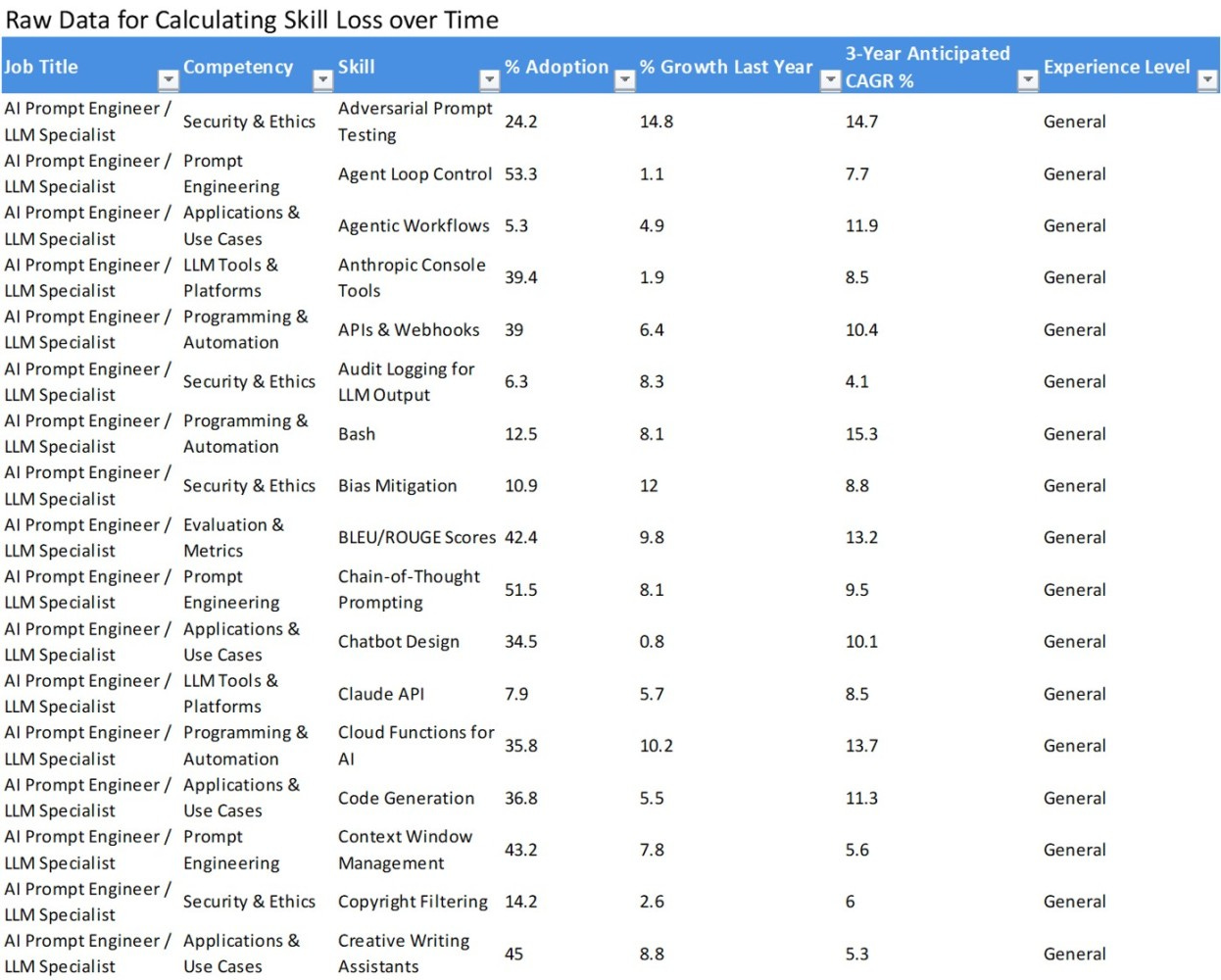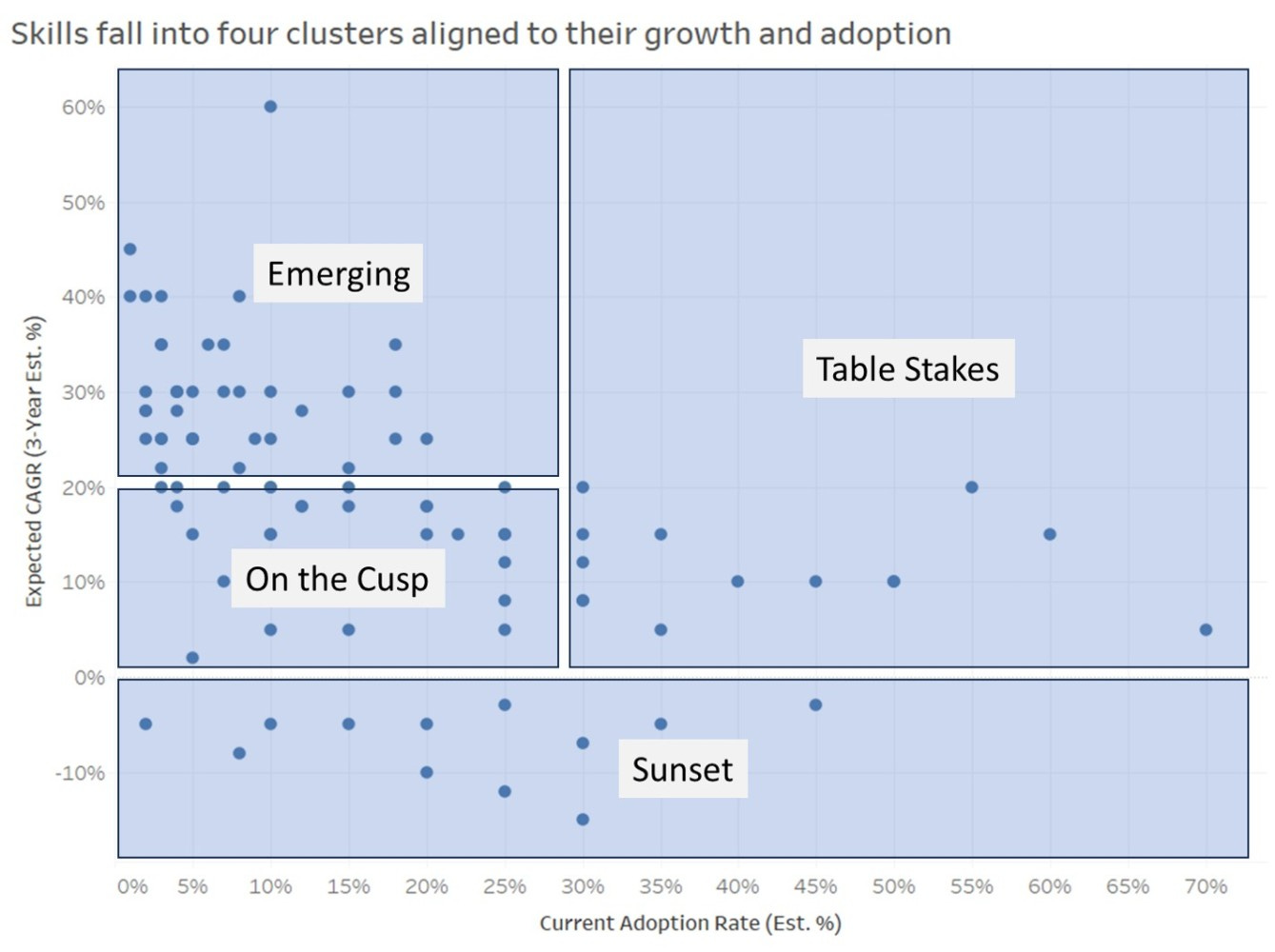Applying the Rule of 72 to Workforce Skill Obsolescence and Productivity Degradation
People Analytics
Thanks to Kristin Saboe, Ph.D. (https://www.linkedin.com/in/ksaboe/) for her thoughtful edits and collaboration on this article.
I suspect the phrase “lifelong learning” isn’t new to you. But knowing how important it is, and how much of it you need to do, isn’t always easy to quantify. In this article, I’m going to take a crack at it. Fair warning: I’m borrowing (okay, stretching) some financial logic to make a point, but stay with me.
By blending workforce data with a flipped version of the Rule of 72, a classic shortcut from finance used to estimate how long it takes an investment to double. The idea is simple: divide 72 by an annual growth rate, and you’ll get the number of years it takes to double your money. For example, at a 6% return, your investment would double in 12 years (72 ÷ 6 = 12).
Now imagine turning that logic upside down, using it not to calculate growth, but to estimate decline. By blending this with workforce data, I’ll walk through a way to forecast the degradation of skill relevance over time, giving you a practical tool to understand just how fast your role, or your team’s, might be falling behind.
Define the Skill Composition of a Role
Start with understanding what skills define a role today, and where those skills are heading. For each skill in a job family, collect two key metrics: 1/ Current Adoption: the % of people in the role who have the skill today, and 2/ 3-Year CAGR: the projected compound annual growth rate of that skill over the next three years. Note that a 3-year Compound Annual Growth Rate (CAGR) represents the steady annual growth rate at which a value would have increased over a three-year period if it had grown at the same rate each year, when compounding annually.
To keep this exploratory, I used ChatGPT to simulate the data. Based on findings from my prior article, Gemini and Claude are potentially better options with higher accuracy. But if you're serious about this in practice, I strongly recommend using vetted sources like LinkedIn Talent Insights or Draup. Even if CAGR projections aren't available, past year-over-year growth can be a helpful proxy.
Here’s a snapshot of what this data might look like. For context: skills map to competencies, which map to jobs. So, for example, SQL is a skill within the programming competency for the role of Data Scientist.

Flip the Rule of 72
In finance, the Rule of 72 is a mental shortcut to estimate how long it takes an investment to double:
72 ÷ annual growth rate = years to double your money
Let’s flip that logic. Instead of asking when your portfolio will double, ask when your current skillset will be overwritten.
72 ÷ weighted average 3-Year CAGR = years to obsolescence
To calculate that weighted average, multiply each skill’s adoption % by its 3-Year CAGR, sum it, and divide by the total adoption %. If a role’s resulting CAGR is 9%, then:
72 ÷ 9 = 8 years to being outdated, if no upskilling or reskilling occurs. That is also to suggest that they decline by 100 / 8 = 12.5% each year (on a straight line).
This doesn’t mean every skill in the role disappears overnight, of course. But it signals how fast the competencies in a job are shifting beneath our feet.
Visualize Across Roles
To test this framework in action, I ran the analysis across ten different job titles, using simulated data to represent a range of functions from technical to operational roles. While I don’t claim these numbers are precise, I do believe they are directionally accurate, particularly in reflecting the relative pace of skill evolution from one role to another. In other words, this model helps us understand the magnitude of the difference in capability decay across jobs. It passes the “eye test” in the sense that it feels intuitively correct: an AI Prompt Engineer, for example, must refresh and expand their skills far more frequently than a Construction Project Manager. The need for continual reinvention in tech-forward roles isn’t just a gut feeling; it shows up in the data.
To reiterate, if this approach is something you want to use more formally within your organization, I’d strongly recommend sourcing the data from trusted providers like LinkedIn Talent Insights or Draup. They can give you access to real-time adoption patterns and, in some cases, future-facing growth forecasts for specific skills. If CAGR data isn’t available, prior year-over-year trends can still serve as a solid proxy. The idea here isn’t to create a crystal ball, more of a smarter compass.
Now, let’s talk about the visualization itself. In the bar chart that follows, you’ll see three key columns for each role. The first is the Felt Growth Rate, which is a weighted average of the 3-year CAGR across all the skills in that job. If this number is 6%, that means the collective skill makeup of the role is evolving at a 6% annual rate. The second column takes that rate and divides it into 72, following the flipped Rule of 72 logic introduced earlier. This result tells us, directionally, how many years it takes for the average skill profile of the role to be overwritten.
Finally, the third column estimates how much capability or productivity might erode each year if someone in that role fails to grow with the field. Again, this isn’t a literal loss, it’s a directional gauge. Of course, there are evergreen skills in every job: a data scientist who never learns a new tool but still knows SQL and Python is not useless. But over time, their value diminishes if the broader industry has moved on to more advanced tools, frameworks, or methods. That erosion may be subtle, but it’s cumulative and critical.
So if you’re comparing roles like AI Prompt Engineer and Operations Manager, the message is clear: both need to learn, but one needs to do it at nearly double the pace. Investing in training, certifications, and self-directed learning isn’t just a good idea; it’s the only way to keep up in roles where the skill cycle moves at warp speed.
A General Understanding of Skill Clusters
As mentioned earlier, generative AI tools can be helpful for producing directionally correct skill forecasts. While ChatGPT struggled to generate a sufficient range of skills showing contracting growth over a 3-year horizon, Gemini produced a more complete and nuanced set, including skills across both rising and declining trajectories. The scatter plot (Figure 3) below visualizes these results, and several intuitive clusters emerge, many of which align with established models of skill evolution seen in earlier workforce literature. These clusters are meant to be in a broad, general sense and applicable across all skills for any talent pool.
The skills are categorized into four key zones: 1/ Emerging Skills with low current adoption but skyrocketing demand. These represent the cutting edge, including areas like Generative AI, and reward early adopters with disproportionate influence and opportunity (20%+ CAGR, <30% Adoption); 2/ Table Stakes that are widely adopted, foundational skills with steady or modest growth. These are must-haves for most roles in the field, think core programming languages or agile methodologies (0%+ CAGR, >30% Adoption); 3/ On the Cusp with moderate to high adoption and healthy, sustained expansion. Examples include cloud architecture or data engineering, which offer reliable long-term value for career development (0% - 20% CAGR, <30% Adoption); 4/ Sunset are still in use today, but are experiencing declining demand. Roles anchored in manual testing or on-prem infrastructure will need intentional upskilling strategies to stay relevant. Some skills are relevant only in legacy niches and unlikely to return to widespread relevance (<0% CAGR).
This framework helps orient professionals, leaders, and L&D teams around where to double down, where to pivot, and where to let go, with data to back it up.

The Skill Scatter
Reverting back to the role-specific data, I visualized each individual skill on a scatterplot. On the x-axis, we have the current adoption rate. That is, the percentage of people in the role who currently possess the skill. On the y-axis, we see the projected 3-year CAGR for each skill, or how fast demand for that skill is expected to grow.
This simple two-dimensional view reveals a lot. In the top-right quadrant, where both adoption and growth are high, you’ll find the skills that are already broadly accepted and accelerating. These are what I refer to as the “table stakes”. While they may not be the most innovative or rare, they represent the foundational skills that everyone in a role will likely be expected to have.
Now shift your attention to the top-left quadrant, low adoption, high growth. This is where the emerging skills live. They haven’t hit widespread usage yet, but they’re growing fast. These are your early indicators, the frontier of what may become mainstream. As a historical example, chatbot-related skills like natural language understanding and conversation design appeared in this space for multiple job families years before tools like Gemini went mainstream. Had you spotted that pattern early, you would’ve had a head start on where the market and the capabilities were headed.
It’s important to note that the view below is completely unfiltered. There’s no clustering or trimming of outliers yet. This is the starting point, a raw snapshot of the skill ecosystem before we narrow our lens. From here, we can zoom in on specific quadrants, skill types, or role families.
Zooming In on the Top-Right
Let’s highlight a few of those “table stakes” skills in the top-right. These are the skills that are already dominant and still growing. Focusing on these can offer a strong return on upskilling investment.
Zooming In on the Top-Left
Now let’s look at the “emerging” quadrant. Here you’ll find early adopters experimenting with new tooling and capabilities. Many of these skills are still maturing, likely found somewhere between the Innovation Trigger and Peak of Inflated Expectations on the Gartner Hype Cycle.
The Ramifications
This framework isn’t just theoretical; it has practical implications for how organizations invest in people and how individuals manage their careers. Training budgets, for example, can now be guided by real data instead of intuition. Rather than spreading development dollars evenly or reactively, leaders can target investment toward roles and competencies where skill growth is rapid and obsolescence risk is high. These are the areas where falling behind isn’t just inconvenient, it’s career-limiting.
The same logic applies at the individual level. This model gives managers a clearer way to coach employees not only on what to learn, but when. That timing dimension transforms the conversation. Instead of vague encouragement around “lifelong learning,” we now have a timeline-backed strategy. Employees can begin to understand when their current capabilities may start to erode in relevance, and how to preempt that decline with proactive upskilling.
When it comes to role design, this perspective prompts a shift in mindset: talent is a dynamic portfolio. It needs regular rebalancing to match the evolution of the skills that define success in a given job. Static roles built on static competencies will always underperform in fast-moving markets. Similarly, hiring priorities should shift toward candidates already building strength in high-growth skills, particularly those residing in the top-right or top-left of the scatterplot. These individuals are either aligned with the current trajectory of the role or they’re ahead of the curve and positioned to lead transformation.
One key takeaway for individuals: learning is always good, but targeted learning is essential. Not all skills are created equal in terms of strategic value or shelf life. You don’t need to chase every shiny tool or trend. Instead, prioritize skill-building in areas that are core to your current role or directly aligned with the role you aspire to hold. That’s where your learning will compound, not just accumulate.
Another critical takeaway for future-focused leaders, strategists, and researchers is this: there’s still a great deal we don’t know. As new technologies are rapidly invented, scaled, and iterated in response to market forces, the corresponding skills and the organizational capacity to integrate them remain in constant flux. If you revisit the theoretical model (Figure 3), you’ll notice a cluster of “on the cusp” capabilities, skills that are still too volatile or undefined to project with confidence.
Take, for example, copyright filtering (Figure 4), which currently sits in that ambiguous middle ground. If the legal and ethical boundaries of copyright in generative and agentic AI had been resolved, the talent strategies surrounding this space would be far more straightforward. But we’re only just beginning to confront questions like: Do AI-generated outputs, such as music or visual art, grant legal rights to the human who prompted them? Or does that represent too many degrees of separation from traditional authorship to warrant copyright protection? These aren’t just tactical or operational dilemmas; they’re philosophical. And the answers to them will shape which skills become critical, which become obsolete, and which sit in limbo for years.
In a world defined by such uncertainty, building frameworks and examining emerging capability patterns becomes essential. Structured models like the flipped Rule of 72 give us a way to measure the velocity of change across roles, helping us anticipate, not just react to, disruption. The goal isn’t perfect prediction; it’s directional clarity. And with that clarity comes smarter workforce planning, sharper talent strategy, and more intentional career development for individuals navigating this evolving terrain.
Thanks for reading!
-Scott (and thank you again to Kristin!)
And of course, a quick plug for a side project I built for my kids. It’s a daily news summary that pulls from liberal, conservative, and moderate sources, highlighting where they agree and where they diverge, all in a quick, 3-minute read. Check it out and stay informed from every angle.
Let’s keep the conversation going and explore how we can collectively prepare for and shape the future of work. Your feedback and insights are invaluable. Please like, comment, and let’s keep these ideas flowing!
Disclaimer: The views and opinions expressed in this article are solely those of the author and do not reflect the official policy or position of any current or former employer. Any content provided in this article is for informational purposes only and should not be taken as professional advice.
#WorkforcePlanning #Upskilling #FutureOfWork #PeopleAnalytics #SkillsStrategy #RuleOf72 #TalentManagement #Reskilling #CareerDevelopment #EmergingTech








